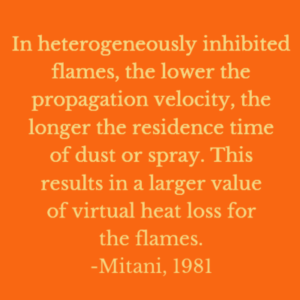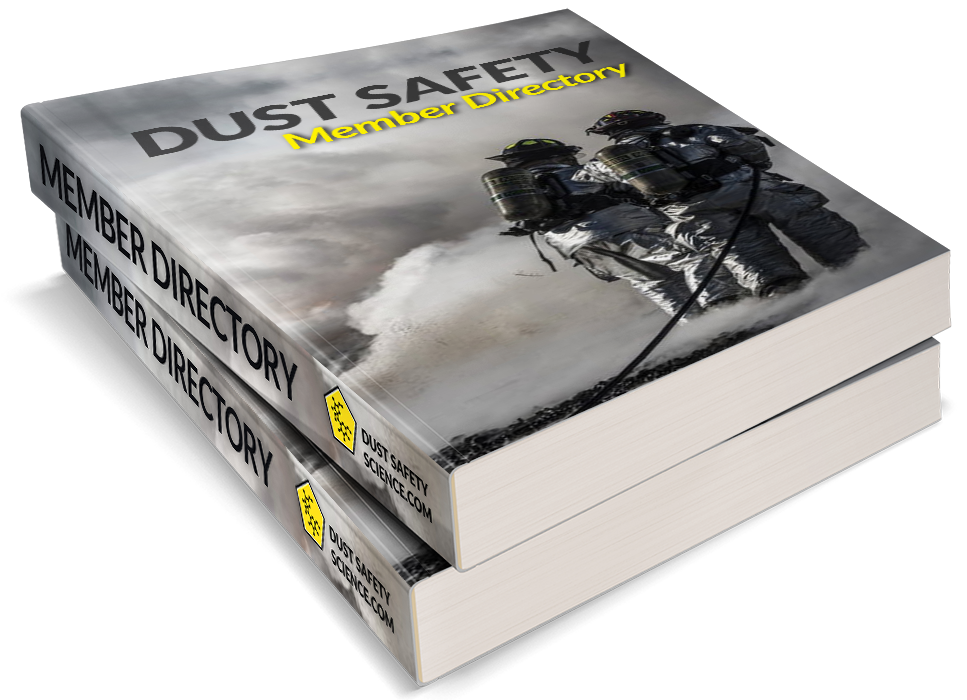1-Sentence-Summary: The role of dust and spray diameter, thermal capacitance, and preheat zone thickness is explored for premixed flame suppression.
Authors: T. Mitani
Read in: Three Minutes
Favorite quote from the paper:

The current author develops a mathematical model demonstrating premixed flame inhibition by inert dusts and evaporating sprays. During the nondimensionalization process, two key parameters are identified: the overall thermal capacitance of the suppressant, and the normalized dust or spray diameter.
The mathematical model assumes the dust or droplets have a single size and that they are in mechanical equilibrium with the fluid . Unity Lewis number and low flame velocities are also assumed.
The model is used to explore reduction in premixed propagation velocity by dusts and sprays. The results are presented in nondimensionalized form and the impact of the two key parameters are identified.
Three of the main findings from this paper are:
- Preheat zone thickness of the premixed flame is a key parameter for flame suppression.
- A negative feedback loop occurs between the reduction in flame speed and addition of inhibiting solids or liquids.
- Flame suppression by chemical inhibition can be included by determining a reduced “effective” particle diameter.
The following sections outline the main findings in more detail. The interested reader is encouraged to view the complete article at the link provided below.
Finding #1: Preheat zone thickness is a critical parameter for flame inhibition
The author found that the preheat zone of the premixed flame is a critical parameter for understanding flame suppression. Flame inhibition can be determined by the flame velocity, heat transfer timescale, and preheat zone thickness. If the dust or spray can remove energy from the flame front before the reaction zone, the propagation velocity will be reduced.
Finding #2: Flame cooling has a negative feedback loop with preheat zone thickness
The author found a negative feedback loop between flame suppression and preheat zone thickness. As the propagation velocity is reduced, the preheat zone becomes thicker. This allows more time for the dust or droplet to remove heat from the flame, further reducing the flame speed.
Finding #3: Chemically active dust can be included using an “effective” particle diameter
The author proposes that the current model can be extended to chemically active suppressants in a simple manor. He assumes that the chemical suppressing effect can be estimated by a virtual reduction in the Arrhenius pre-exponential factor. If this is the case, then the overall impact can be captured in the model by computing an effective reduction in particle diameter, corresponding to the chemical suppression effect.
My Personal Take-Aways From
“A Flame Inhibition Theory by Inert Dust and Spray”
This paper builds on the work of Rosser et al., 1963, Dewitte et al., 1964, Sridhar Iya et al., 1974, and Buckmaster, 1976, and adds the effect of spray evaporation and chemical suppressant. This research is important for explosion suppression and is continued in various forms today. Furthermore, combined with multiphase combustion, thermal inhabitation may play an important role in understanding explosion limits of hybrid mixtures of flammable gas and combustible dust.
Full Citation: [bibtex file=references.bib key=Mitani1981]
